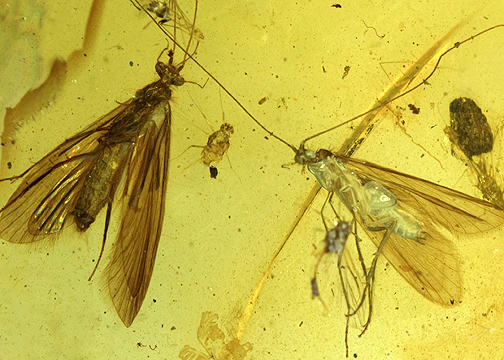Abstract
The family Palleptoceridae fam. nov. is proposed as a new extinct family of the superfamily Leptoceroidea. It is characterized by the absence of ocelli, the presence of five-segmented maxillary palps in both sexes, antennae longer than the forewings, and the tibial spur in the form of 2/4/4. The extinct Palleptoceridae is closely related to the leptoceroid family Leptoceridae, but the formula for the adult tibial spur is reduced from 2/4/4 to 2/2/4 (Morse, 1981). The Palleptocerus grimaldii sp. nov. from the mid-Cretaceous Burmese amber is furthermore characterized by the sexual dimorphic wing venation. In the forewings, the apical forks I and V are present in the male and forks I, III, and V in the female; in the hind wings of both sexes, exclusively the apical fork V is present. The Leptoceroidea originated and evolved in Gondwana. Palleptocerus grimaldii sp. nov. is interpreted as a relict species of the Gondwanan Leptoceroidea in Burmese amber.
References
- Čerňanský, A., Stanley, E., Daza, J., Bolet, A., Arias, S., Bauer, A., Vidal García, M., Bevitt, J., Peretti, A., Aung, N. & Evans, S. (2022) A new Early Cretaceous lizard in Myanmar amber with exceptionally preserved integument. Scientific Reports, 12, 1660. https://doi.org/10.1038/s41598-022-05735-5
- Dias, E.S. (2020) Systematic and biogeography of Leptoceridae (Trichoptera) with review of Achoropsyche Holzenthal, 1984. Tese de Doutorado, Universidade de São Paulo, vi+106 pp.
- Kania, I., Wang, B. & Szwedo, J. (2015) Dicranoptycha Osten Sacken, 1860 (Diptera, Limoniidae) from the earliest Upper Cretaceous Burmese amber. Cretaceous Research, 52, 522–530. https://doi.org/10.1016/j.cretres.2014.03.002
- Kirby, W. (1813) Strepsiptera, a new order of insects proposed, and the characters of the order, with those of its genera. Transactions of the Linnean Society of London, Zoology, 11, 86–122. https://doi.org/10.1111/j.1096-3642.1813.tb00040.x
- Leach, W.E. (1815) Entomology. In: Brewster, A. (Ed.), The Edinburgh Encyclopedia, 1, 57–172.
- Malm, T. & Johanson, K.A. (2011) A new classification of the long-horned caddisflies (Trichoptera: Leptoceridae) based on molecular data. BMC Evolutionary Biology, 11 (10), 1–17. http://www.biomedcentral.com/1471-2148/11/10
- Malm, T., Johanson, K.A. & Wahlberg, N. (2013) The evolutionary history of Trichoptera (Insecta): a case of successful adaptation to life in freshwater. Systematic Entomology, 38, 459–473. https://doi.org/10.1111/syen.12016
- Martynov, A.V. (1924) Rucheiniki [caddisflies] (Trichoptera). In: Bogdanov-Kat’kov, N.N. (Ed.), Prakticheskaya entomologiya [Practical entomology]. Vol. 5, Leningrad, pp. 1–388. [In Russian]
- Mashimo, Y., Müller, P. & Beutel, R. (2019) Zorotypus pecten, a new species of Zoraptera (Insecta) from mid-Cretaceous Burmese amber. Zootaxa, 4651 (1), 565–577. https://doi.org/10.11646/zootaxa.4651.3.9
- Metcalfe, I. (2013) Gondwana dispersion and Asian accretion: tectonic and palaeogeographic evolution of eastern Tethys. Journal of Asian Earth Sciences, 66:1–33. https://doi.org/10.1016/j.jseaes.2012.12.020
- Metcalfe, I. (2017) Tectonic evolution of Sundaland. Bulletin of the Geological Society of Malaysia, 63, 27–60. https://doi.org/10.7186/bgsm63201702
- Morse, J.C. (1981) A phylogeny and classification of family-group taxa of Leptoceridae (Trichoptera). Proceedings of the 3rd International Symposium on Trichoptera. Series Entomologia, Dr. W. Junk, The Hague, pp. 257–264. https://doi.org/10.1007/978-94-009-8641-1_32
- Oliveira, I., Bai, M., Jahn. H., Gross, V., Martin, C., Hammel, J., Zhang, W. & Mayer, G. (2016) Earliest Onychophoran in amber reveals Gondwanan migration patterns. Current Biology, 26, 2594–2601. https://doi.org/10.1016/j.cub.2016.07.023
- Pohl, H., Wipfler, B., Boudinot, B. & Beutel, R.-G. (2021) On the value of Burmese amber for understanding insect evolution: Insights from †Heterobathmilla—an exceptional stem group genus of Strepsiptera (Insecta). Cladistics, 37, 211–229. https://doi.org/10.1111/cla.12433
- Poinar, G.O. Jr. (2018) Burmese amber: evidence of Gondwanan origin and Cretaceous dispersion. Historical Biology, 31, 1304–1309. https://doi.org/10.1080/08912963.2018.1446531
- Shi, G., Grimaldi, D.A., Harlow, G.E., Wang, J., Yang, M., Lei, W., Li, Q. & Li, X. (2012) Age constraint on Burmese amber based on U-Pb dating of zircons. Cretaceous Research, 37, 155–163. https://doi.org/10.1016/j.cretres.2012.03.014
- Thomas, J. A., Frandsen, P. B., Prendini, E, Zhou, X. & Holzenthal, R.W. (2020) A multigene phylogeny and timeline for Trichoptera (Insecta). Systematic Entomology, 45, 670–686. https://doi.org/10.1111/syen.12422
- Wichard, W. (2021) Overview of the caddisflies (Insecta, Trichoptera) in mid-Cretaceous Burmese amber. Cretaceous Research, 119, 104707. https://doi.org/10.1016/j.cretres.2020.104707
- Wichard, W., Ross, E. & Ross, A. (2011) Palerasnitsynus gen. n. (Trichoptera, Psychomyiidae) from Burmese amber. ZooKeys, 130, 323–330. https://doi.org/10.3897/zookeys.130.1449
- Wichard, W., Müller, P. & Wang, B. (2018) The psychomyiid genus Palerasnitsynus (Insecta, Trichoptera) in mid-Cretaceous Burmese amber. Palaeodiversity, 11, 151–166. https://doi.org/10.18476/pale.11.a8


